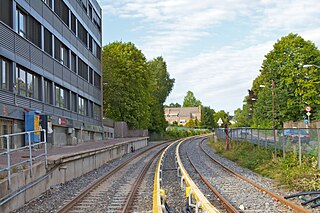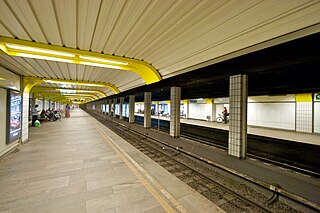
The Oslo Metro is the rapid transit system of Oslo, Norway, operated by Sporveien T-banen on contract from the transit authority Ruter. The network consists of five lines that all run through the city centre, with a total length of 85 kilometres (53 mi), serving 101 stations of which 17 are underground or indoors. In addition to serving 14 out of the 15 boroughs of Oslo, two lines run to Kolsås and Østerås, in the neighboring municipality of Bærum. In 2016, the system had an annual ridership of 118 million.

Stortinget is an underground rapid transit station on the Common Line of the Oslo Metro, Norway. It is located in the heart of the city center, next to the Parliament of Norway Building (Stortinget). The station is served by all six lines of the metro. At the street level, the station serves tram routes 11, 17, and 18 on the Ullevål Hageby Line as Tinghuset and Prof. Aschehougs gate. Stortinget is 'kilometer marker zero' for the metro network and is owned by Kollektivtransportproduksjon.

The Holmenkollen Line is an 11.4-kilometre-long (7.1 mi) Oslo Metro line which runs between Majorstuen and Nordmarka in Oslo, Norway. Operating as Metro Line 1, it is the route with the fewest passengers and the only one still to have level crossings and short station platforms. The line runs mostly through residential areas of detached houses, and the upper parts of the line principally serve the recreational area of Nordmarka. Holmenkollen Station is located close to Holmenkollen National Arena which hosts international Nordic skiing tournaments. Voksenkollen Station is not far from Oslo Vinterpark (Winter) and the Oslo Sommerpark (Summer).

The Røa Line is a rapid transit line of the Oslo Metro, Norway, which runs from Majorstuen in Oslo to Østerås in Bærum. It serves neighborhoods such as Smestad, Hovseter, Huseby and Røa in northwestern Oslo, and Grini, Øvrevoll and Østerås in northeastern Bærum. The line is served by Line 2 of the metro, which connects to the city center via the Common Tunnel and onwards along the Furuset Line. The lowest part of the Røa Line, consisting of two stations, is shared with the Kolsås Line, and thus also served by Line 2 of the metro. The Røa Line is owned by Kollektivtransportproduksjon, and operated by Oslo T-banedrift on contract with the public transport agency Ruter.

The Sognsvann Line is a rapid transit line on the Oslo Metro of Norway. It branches from the Common Tunnel at Majorstuen and runs 6.0 kilometers (3.7 mi) to Sognsvann. After Ullevål stadion, the Ring Line branches off. The Sognsvann Line serves the northwestern and northern neighborhoods of Oslo, mostly within the borough of Nordre Aker. The line is owned and maintained by Kollektivtransportproduksjon and has nine stations. The western end of line 5 serves the entire line. Line 4 and the eastern end of line 5 serve the southern part of the line up to Ullevål stadion before branching off and continuing along the Ring Line. This gives an average five-minute headway on the southern part and an average fifteen-minute headway on the northern part of the line.

The Østensjø Line is a 9.0-kilometre (5.6 mi) line on the Oslo Metro which runs from Brynseng to Mortensrud. It further shares track with the Lambertseter Line along the 2.5-kilometre (1.6 mi) section from Tøyen to Brynseng. The line runs through the primary residential areas of Bøler, Østensjø and Søndre Nordstrand. The line is served by Line 3 of the metro.

The Kolsås Line is a 12.1-kilometer (7.5 mi) line of the Oslo Metro. It branches off from the Røa Line at Smestad Station and runs through western Oslo and Bærum to Kolsås Station. It serves the neighborhoods of Ullernåsen, Øraker, Jar, Bekkestua, Haslum, Gjettum and Kolsås. It is served by Line 3 of the metro at a 15-minute headway. The section from Jar to Bekkestua is built as a dual system with overhead wires, allowing Line 13 of the Oslo Tramway to continue from the Lilleaker Line to Bekkestua every ten minutes.

The Ring Line is the newest rapid transit loop line of the Oslo Metro of Oslo, Norway. It connects to the Sognsvann Line in the west and the Grorud Line in the east; along with these two lines and the Common Tunnel, the Ring Line creates a loop serving both the city centre and Nordre Aker borough. The 5.0 kilometres (3.1 mi)-long line has three stations: Nydalen, Storo and Sinsen. Four-fifths of the line runs within two tunnels, with the 1.0-kilometer (0.62 mi) section between Storo and Sinsen, including both stations, being the only at-grade part. The line connects to the Grorud Line north of Carl Berners plass and with the Sognsvann Line north of Ullevål stadion.

The Common Tunnel, sometimes called the Common Line, is a 7.3-kilometer (4.5 mi) long tunnel of the Oslo Metro which runs through the city center of Oslo, Norway. The name derives from the fact that all six lines of the metro use the tunnel, which runs from Majorstuen to Tøyen. The section has six stations, including the four busiest on the metro.

AS Oslo Sporveier is a defunct municipal owned company responsible for public transport in Oslo, Norway. It was created in 1924 to take over the city's two private tram companies. In 1927 its started with bus transport, including from 1940 to 1968 trolleybuses. Since 1966 rapid transit and from 1985 water buses have also been operated by the company. It was split into two separate companies in 2006; Kollektivtransportproduksjon took over the operation while Oslo Public Transport Administration was responsible for buying the services, fare regulation and marketing. The latter merged into Ruter in 2008, when the Oslo Sporveier brand was discontinued.

Østhorn is a station on the Sognsvann Line of the Oslo Metro in Norway. It is located 7.1 kilometres (4.4 mi) from Stortinget station between Tåsen and Holstein stations. As one of the original stations on the line, Østhorn was opened on 10 October 1934. Nordberg was formerly the next northbound station, but it was closed in 1992, when the Sognsvann Line was upgraded to metro standard. Østhorn is located near a hill named Havnabakken, where local residents toboggan at winter's time.

Nationaltheatret is an underground metro station and tram stop serving Vika and the city center of Oslo, Norway. It is located on the Common Tunnel of the Oslo Metro and on the Briskeby Line of the Oslo Tramway. Also located at the same place is Nationaltheatret Station of the Drammen Line. The station is served by all six lines of the metro, and lines 13 and 19 of the tramway. In addition, several bus services call at the station. It is named for the National Theatre located nearby.
A/S Akersbanerne was a municipal owned company that operated tramways in the former Municipality of Aker in current Oslo, Norway. The company was established in 1917, and opened the suburban Østensjø Line tramway in 1926; it took over the majority ownership of Holmenkolbanen in 1933, that owned the Holmenkoll Line, Sognsvann Line and the Røa Line. Akersbanerne merged with Oslo Sporveier in 1949, following the merger of the municipalities.
A/S Kristiania Elektriske Sporvei or KES, nicknamed the Blue Tramway, was a company which operated part of the Oslo Tramway between 1894 and 1924. It built a network of four lines in Western Oslo, the Briskeby Line and the Frogner Line which ran to Majorstuen, and two other consecutive lines, the Skøyen Line and the Lilleaker Line. These all connected to a common line through the city center which terminated at Jernbanetorget.
A/S Bærumsbanen was a tram company that operated the Lillaker-, Kolsås and Østensjø Line of the Oslo Tramway, Norway, from 1924 to 1971 when the company became part of Oslo Sporveier.

Vestgrensa was a light rail station on the Sognsvann Line of the Oslo Metro in Norway. It opened on 10 October 1934, and was located between Blindern and Ullevål stadion stations. The station was rebuilt when the Sognsvann Line was upgraded from light rail to metro standard in the early 1990s. It was closed on 22 August 1999, when it was replaced by the new station Forskningsparken.

Volvat was a rapid transit station of the Oslo Metro's Røa Line and Kolsås Line. Situated in the neighborhood of Volvat in Vestre Aker borough of Oslo, Norway, it was the sole underground station on the western part of the metro. It was located 3.4 kilometers (2.1 mi) from Stortinget.

The history of the Oslo Tramway and Oslo Metro in Oslo, Norway, starts in 1875, when Kristiania Sporveisselskab (KSS) opened two horsecar lines through the city centre. In 1894, Kristiania Elektriske Sporvei (KES) built the first electric street tramways, which ran west from the city centre. Within six years, all tramways were electric. The city council established Kristiania Kommunale Sporveie (KKS) in 1899, which built three lines before it was sold to KSS six years later. Both KSS and KES were taken over by the municipality in 1924, becoming Oslo Sporveier. The company gradually expanded the city tram network, which reached its peak length in 1939.
Homansbyen is a tram stop located at Homansbyen in Frogner borough of Oslo, Norway. It is on the Homansbyen Line, a short line that connects the Briskeby Line and Ullevål Hageby Line of Oslo Tramway, and is served by line 11 using SL79 trams. This line is the shortest of the three tram lines that connect the city centre with Majorstuen. The city has planned to build a new rapid transit station for the Oslo T-bane at Homansbyen, but as of 2017 this has not been developed.
























